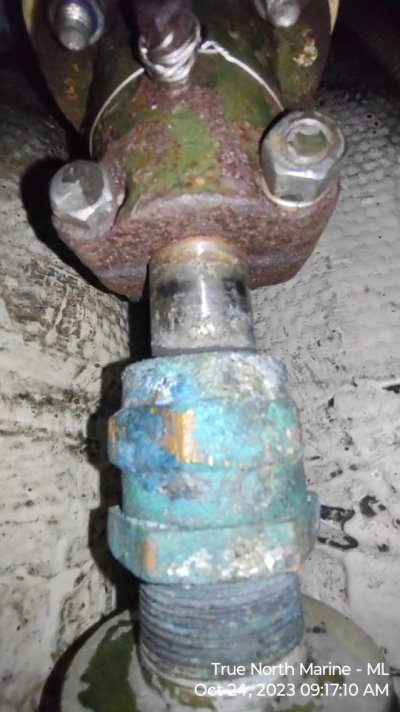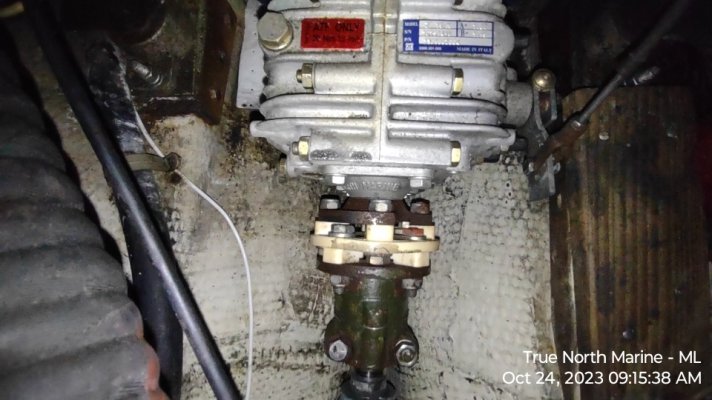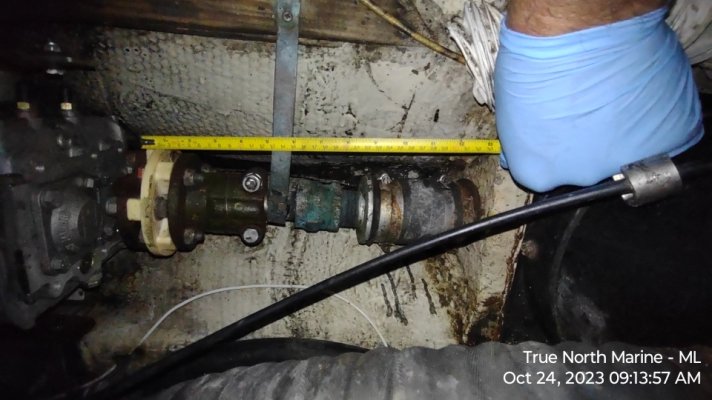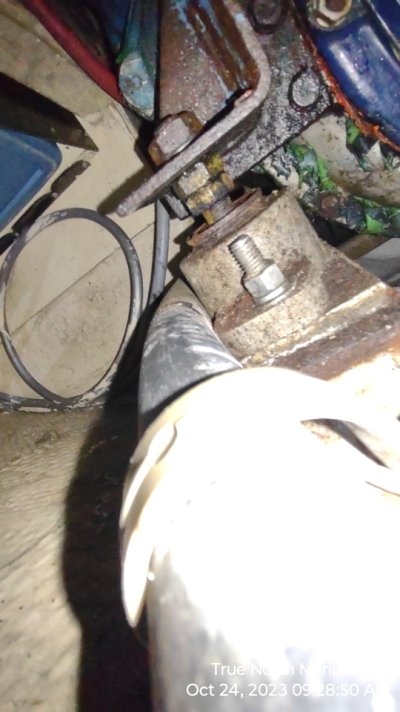You are using an out of date browser. It may not display this or other websites correctly.
You should upgrade or use an alternative browser.
You should upgrade or use an alternative browser.
Rudder shaft alignment
- Thread starter No Mas
- Start date
Warren Holybee
Active Member
I am not understanding the question. There is not anything to align on the rudder shaft. Can you post a picture?
Warren Holybee
Active Member
Ah that makes more sense. The shaft needs to be aligned in two ways. It needs to be centered properly, and it needs to be flat. Here is an overview:
First, you have a flexible adapter, the white part. That allows a slight misalignment, but you should still get it as close as possible. So remove it for the procedure. Because this will move the shaft forward, you might need to remove the shaft anode.
Next bring the coupling halves together. If your cutlass is worn, you might need to support it in a centered position. Adjust the motor mounts so that the couplings meet center to center.
That is the easy part. For the next part, the two halves need to meet flat, within about 3 thousands of an inch. To do this, I take a .003 or .002 feeler gauge, and cut it, so I have a slip or ribbon (instead of the gauge attached to the tool) I bolt the two halves together, with the slip inserted at one of the bolts. Do not torque them, just a bit more than finger tight. Rotate the shaft a few turns, and see if the slip falls out. If it does, that is the misalignment, move the _front_ of the engine to change the angle and close the gap. Then, move the slip to another bolt and repeat. After about 10 times, hopefully you can put the slip in any position, and it will not fall out.
Once the second part is done, you might have moved the front of the engine enough to mess up the first part, so check that again, and if necessary, repeat both alignments again. Once both are done, reinstall the flexible adapter, and if necessary the anode.
It is a lot of work. I might consider buying new motor mounts first to avoid doing it twice. If it is off, it is probably because your mounts are worn out (or was never done properly to being with).
First, you have a flexible adapter, the white part. That allows a slight misalignment, but you should still get it as close as possible. So remove it for the procedure. Because this will move the shaft forward, you might need to remove the shaft anode.
Next bring the coupling halves together. If your cutlass is worn, you might need to support it in a centered position. Adjust the motor mounts so that the couplings meet center to center.
That is the easy part. For the next part, the two halves need to meet flat, within about 3 thousands of an inch. To do this, I take a .003 or .002 feeler gauge, and cut it, so I have a slip or ribbon (instead of the gauge attached to the tool) I bolt the two halves together, with the slip inserted at one of the bolts. Do not torque them, just a bit more than finger tight. Rotate the shaft a few turns, and see if the slip falls out. If it does, that is the misalignment, move the _front_ of the engine to change the angle and close the gap. Then, move the slip to another bolt and repeat. After about 10 times, hopefully you can put the slip in any position, and it will not fall out.
Once the second part is done, you might have moved the front of the engine enough to mess up the first part, so check that again, and if necessary, repeat both alignments again. Once both are done, reinstall the flexible adapter, and if necessary the anode.
It is a lot of work. I might consider buying new motor mounts first to avoid doing it twice. If it is off, it is probably because your mounts are worn out (or was never done properly to being with).
terry_thatcher
Terence Thatcher
Depends on where you are. Common item at any shop that sells or installs marine engines. Or any of the marine supply outlets on line: PYI, Defender, Fisheries Supply. Get heavy duty ones. Not cheap, but a critical component.
Warren Holybee
Active Member
About motor mounts. The assembly of the engine on the mounts will have a resonant frequency. That frequency is dependent on the weight of the engine(divided by 4), the design of the mounts, and the stiffness of the mount (durometer). When the engine runs at the same RPM/60 as the resonant frequency (Hz), it will vibrate like crazy. So, you need to select a durometer that will cause the resonant frequency to not be in the operating range of the engine.
The durometer should be stamped on you current mounts. It should be a number between 45 and 75. Since it also depends on mount design, if you buy the same mount, you can buy one of the same durometer. But if you buy a different mount, the required durometer might change and you will need to check with the manufacturer of that mount for proper selection.
As an example, here is the product sheet for a popular type of mount(but different from what you have), with the charts used for selection:
The durometer should be stamped on you current mounts. It should be a number between 45 and 75. Since it also depends on mount design, if you buy the same mount, you can buy one of the same durometer. But if you buy a different mount, the required durometer might change and you will need to check with the manufacturer of that mount for proper selection.
As an example, here is the product sheet for a popular type of mount(but different from what you have), with the charts used for selection:
terry_thatcher
Terence Thatcher
Thanks, Warren. I had no idea of these issues. I just trusted my boat yard to install the mounts,
john english
Member
I have 6 Vetus Mitstuen mounts specially designed for 3 cylinder engineshttps://defender.com/assets/pdf/vetus/vetus_motor_mounts_catelog.pdf
terry_thatcher
Terence Thatcher
Warren, my yard also told me that when I engage ward gear, the engine will move forward some. Important to know how much it moves in order to make sure a shaft zinc does not obstruct the cutless bearing. Does this conform with your understanding?About motor mounts. The assembly of the engine on the mounts will have a resonant frequency. That frequency is dependent on the weight of the engine(divided by 4), the design of the mounts, and the stiffness of the mount (durometer). When the engine runs at the same RPM/60 as the resonant frequency (Hz), it will vibrate like crazy. So, you need to select a durometer that will cause the resonant frequency to not be in the operating range of the engine.
The durometer should be stamped on you current mounts. It should be a number between 45 and 75. Since it also depends on mount design, if you buy the same mount, you can buy one of the same durometer. But if you buy a different mount, the required durometer might change and you will need to check with the manufacturer of that mount for proper selection.
As an example, here is the product sheet for a popular type of mount(but different from what you have), with the charts used for selection:
Warren Holybee
Active Member
Yes, it will move. I don't know how much, but with a good new well deigned mount it should not be very much. The mounts are designed to move in some directions for isolation, but not fore/aft. Of course the zinc should be some distance away from the cutlass because it will move.
Also, movement forward will affect the alignment, putting the engine in a different position. But as perfect as the alignment needs to be, I don't think it is normal to accommodate that in the adjustment procedure.
Also, movement forward will affect the alignment, putting the engine in a different position. But as perfect as the alignment needs to be, I don't think it is normal to accommodate that in the adjustment procedure.
Cliff Porter
New Member
What engine was original with these Morgans? Mine was repowered with a 3 cylinder Yanmar. Each motor mount has a different part number, even though they all look exactly the same. I'm willing to bet they all have a different durometer rating in the rubber. Whatever the design concept was, is slightly above my pay grade. Vibration and resonation makes perfict sense. Pretty interesting.
Mitchell S Allen
Active Member
Our 383 "Sonata", has a Perkins 4-108, 48hp +/-
Share:





